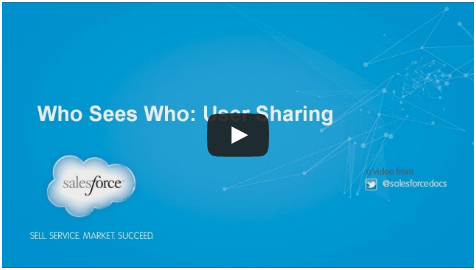As your organization grows and becomes more social, you might want more control over who can see and collaborate with each other among your internal and external users. User Sharing helps you manage your visibility requirements with an organization-wide default for the user object, sharing rules, and manual sharing. With Winter ’14, all new organizations have User Sharing enabled. Existing organizations can contact salesforce.com to enable this feature.
Watch the video to learn more about User Sharing!
How can User Sharing work for your organization? Maybe you are a manufacturer who needs to include all dealers in your organization while still maintaining a silo approach among your dealers and internal users. You can set the organization-wide defaults for the user object to Private. Then, use sharing rules or manual sharing to open up access among internal groups of users who need to see and collaborate with each other. You can also open up access among groups of dealers who need to see and interact with each other. Furthermore, you can enable collaboration between internal sales representatives with their respective dealers. Additionally, you can assign the “View All Users” permission to users who need to see or manage all users in the organization.
In a nutshell, what you know about sharing for standard and custom objects now applies to the user object. For example, you can create a manual share with Apex using the following sample code. Note that Apex sharing reasons is not supported.
To illustrate, running the following code creates a manual share that shares the user whose Id is 005D0000001Qi5c to the user or group whose Id is 00GD0000001Gu79.
Additionally, keep in mind that Visualforce standard controllers run in the user’s context and now respect User Sharing. If you would like access to user information in your email templates, use a custom controller, which defaults to running in the system context without sharing.
